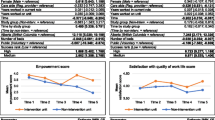Abstract
Accompanying the rise in the number of mental health agency personnel tasked with quality assurance and improvement (QA/I) responsibilities is an increased need to understand the nature of the work these professionals undertake. Four aspects of the work of quality assurance and improvement (QA/I) professionals in mental health were explored in this qualitative study: their perceived roles, their major activities, their QA/I targets, and their contributions. In-person interviews were conducted with QA/I professionals at 16 mental health agencies. Respondents perceived their roles at varying levels of complexity, focused on different targets, and used different methods to conduct their work. Few targets of QA/I work served as indicators of high quality care. Most QA/I professionals provided concrete descriptions of how they had improved agency services, while others could describe none. Accreditation framed much of agency QA/I work, perhaps to its detriment.
Similar content being viewed by others
References
Bellin, E., & Dubler, N. (2001). The quality improvement—Research divide and the need for external oversight. American Journal of Public Health, 91, 1512–1517.
Commission on the Accreditation of Rehabilitation Facilities International. (2008). Child and youth services standards manual, Tuscon, AZ.
Council on Accreditation. (2008). Council on accreditation standards: Private organizations (8th Ed.). Available online at www.COAstandards.org.
Crosby, P. B. (1979). Quality is free: The art of making quality certain. New York: McGraw-Hill.
Deming, W. E. (1986). Out of the crisis. Cambridge, MA: MIT Center for Advanced Engineering.
Donabedian, A. (2003). An introduction to quality assurance in health care. Oxford: Oxford University Press.
Harry, M. J. (1988). The nature of six sigma quality. Schaumburg, IL: Motorola University Press.
Hermann, R. C. (2005). Improving mental health care: A guide to measurement-based quality improvement. Washington, DC: American Psychiatric Press.
Hermann, R. C., Chan, J. A., Zazzali, J. L., & Lerner, D. (2006). Aligning measurement-based quality improvement with implementation of evidence-based practices. Administration and Policy in Mental Health and Mental Health Services Research, 33, 636–645. doi:10.1007/s10488-006-0055-1.
Institute of Medicine. (2006). Improving the quality of health care for mental and substance-use conditions. Washington, DC: National Academy of Sciences.
Joint Commission. (2008). Standards for behavioral health care. Oakbrook Terrace, IL. Kuzel, AJ. Sampling in qualitative research. In B. F. Crabtree & W. L. Miller (Eds.), Doing qualitative research (pp. 33–45). Thousand Oaks, CA: Sage.
Kuzel, A. J. (1999). Sampling in qualitative research. In B. F. Crabtree & W. L. Miller (Eds.), Doing qualitative research (2nd ed., pp. 33–45). Newburty Park, CA: Sage Publications.
Martin, L. L. (1993). Total quality management in human service organizations. Newbury Park, CA: Sage Publications.
Megivern, D. A., McMillen, J. C., Proctor, E. K., Striley, C. W., Cabassa, L. J., & Munson, M. R. (2007). Quality of care: Expanding the social work dialogue. Social Work, 52, 115–124.
Miller, W. L., & Crabtree, B. F. (1999). Depth interviewing. In B. F. Crabtree & W. L. Miller (Eds.), Doing qualitative research (pp. 33–45). Thousand Oaks, CA: Sage.
Pande, P. S., Neuman, R. P., & Cavanagh, R. R. (2000). The six sigma way: How GE, Motorola, and other top companies are honing their performance. New York: McGraw-Hill.
Qualitative Solutions and Research [QSR]. (2006). NVivo 7.0.: Using NVivo in qualitative research [Computer software and manual]. Melbourne, Australia: QSR International.
Shortell, S. M., Bennett, C. L., & Byck, G. R. (1998). Assessing the impact of continuous quality improvement on clinical practice: What it will take to accelerate progress. The Milbank Quarterly, 76, 593–624. doi:10.1111/1468-0009.00107.
Strauss, A., & Corbin, J. (1990). Basics of qualitative research: Grounded theory procedures and techniques. Newbury Park, CA: Sage.
Walton, M. (1990). Deming management at work. New York: Plenum.
Zirps, F., & Cassafer, D. J. (1996). Quality improvement in the agency: What does it take? In P. Pecora, W. R. Seelig, F. Zirps, & S. M. Davis (Eds.), Quality improvement and evaluation in child and family services: Managing into the next century (pp. 145–174). Washington, DC: Child Welfare League of America.
Acknowledgments
This research was supported by a grant from the National Institute of Mental Health (P30 MH 068579).
Author information
Authors and Affiliations
Corresponding author
Appendix
Appendix
Initial questions used to elicit information about QA/I activities, targets and contributions.
Please describe your work as a quality assurance professional.
What are the main priorities of your work, the things you focus attention on?
In general we are interested in things that quality assurance professionals have done that have really made a difference in terms of delivering quality services to patients or consumers. Could you give us an example of something that you have done that has made a difference?
What kinds of work or accomplishments would your supervisor praise you for?
What kinds of activities did you do at work last week? You may want to look at your work calendar to help you answer these questions.
-
What projects were you working on?
-
Who did you meet with?
-
What kinds of routine tasks did you do?
Rights and permissions
About this article
Cite this article
McMillen, C., Zayas, L.E., Books, S. et al. Quality Assurance and Improvement Practice in Mental Health Agencies: Roles, Activities, Targets and Contributions. Adm Policy Ment Health 35, 458–467 (2008). https://doi.org/10.1007/s10488-008-0189-4
Received:
Accepted:
Published:
Issue Date:
DOI: https://doi.org/10.1007/s10488-008-0189-4




